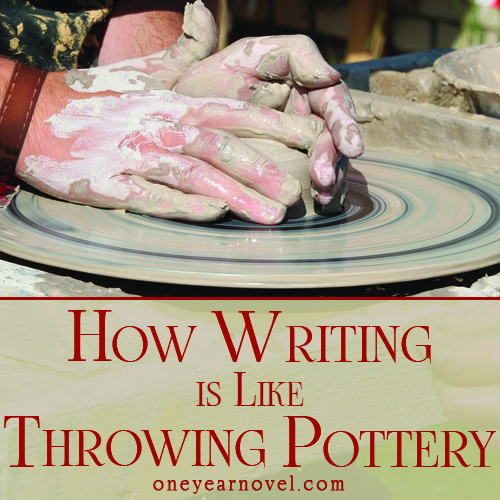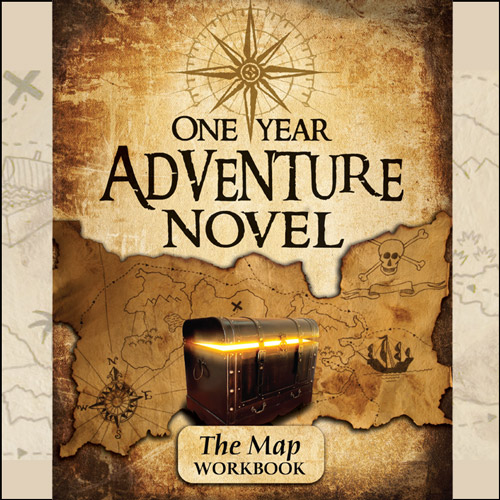How Writing is Like Throwing Pottery
 By Jared Schmitz, Guest Contributor
By Jared Schmitz, Guest Contributor
How do you view the early drafts of your writing projects? Do you view them as blocks of stone requiring smoothing and carving into shape, but essentially complete? Or do you view them more as lumps of clay, likely needing to be fully reshaped more than once?
In the past, I viewed my writing in the first way. I started writing when I was about seventeen, and finished four novels or so in my first year as a writer. It was easy; I had new story ideas every couple of weeks, my projects flowed out like water, and I rarely had trouble finding words. Though I had heard that the real work of writing is actually in the rewriting, I felt that I was probably one of the exceptions to that rule. I never tried to edit any of my rough drafts and thought that they were mostly pretty solid—I even thought I could be published by the time I was twenty!
That was all just fine, until I wrote the first novel that I really consider a failure. It was my fifth, and it was called Little Darkangel. The story had problems on every level—the characters were wooden and unlikable, the plot meandered and petered off into nothing, the setting was underdeveloped, the prose was fluffy and melodramatic. It was a terrible rough draft, and by the time I reached the end, I was exhausted and couldn’t wait to be done. That threw a wrench into the narrative I’d been telling myself. My twentieth birthday came and went without a book being published, and as I continued to write and eventually entered a two-year creative slump, it became increasingly clear that my writing just wasn’t as good as I’d thought it was.
Yet I still had great difficulty finding anything significantly wrong with my rough drafts. Even when I tried to edit them, my second and third drafts would be little different from my first. I still viewed my writing as something almost monumental. Not that I thought it was amazing. But I saw what I had already written as something somewhat immovable, something that would stand for the rest of my life and never be changed significantly. I expected to move some stuff around in later drafts, but that was all. That attitude made it hard for me to write new stories, and even harder to edit my old ones.
I had to learn to let go. This was something I came to through three successive (and successively painful) realizations: a) that much of what I had written would need to be thrown away and remade if it was to become decent; b) that even stories I had thought to be my best were actually riddled with holes; and c) that I wasn’t actually a very good writer at all.
The thing about writing is that it’s not really like carving a frieze in marble. Your rough draft is not a block of stone that only needs to be refined before being set out on a pedestal for all to see. When I lost my confidence in my stories and writing ability, I saw this. Once I was freed of the illusion that I was a really good writer with lots of very strong stories, I saw that writing is actually more like throwing a vase on a potter’s wheel. A rough draft is a lump of clay. Soft, cold, wet, ugly; above all changeable. I saw that everything in my rough drafts could be changed and that much of it needed to be changed.
If you want to write a good story, then you need to let go of what you’ve already written. You need to let go of the idea that your first draft must or can be perfect—or even very good. Think of it in this way. It’s hard work to dig out a big lump of clay from the riverside. You spend a long time finding the perfect type of clay, shoveling it, carting it to your potter’s wheel. You get very dirty. When you throw it into its initial rough shape it seems excellent. You’ve spent so long with that lump of clay that it’s become beautiful to you, and it can seem like there’s nothing else to be done to make it better.
But at the end of the day, it’s just a dirty, ugly lump of wet dirt with the beginnings of a shape. It’s just a rough draft. Most people, looking at it, won’t see the thing that you’ve poured so much sweat and tears into; they’ll just see a mess of plot holes, flat characters, and stilted dialogue. When they say so, it can be enough to make you cry. But if you give it enough time, you’ll also see those things (and this is why we so often hate our old stories). You must not give up. You must remember that it is only a lump of clay, after all, not stone, and it can be changed—it must be changed. So you kick your potter’s wheel into motion and start throwing the story. You’ll probably have to reform it more than once. Bits of it will need to be trimmed away, or other bits added. In the end, it will hardly be recognizable as the lump of clay that it originally was. But that’s how pottery goes; that’s how it should be.
It is at this point that I began to realize that a “good writer” wasn’t really what I had thought it was—someone who can tell an amazing story on the first try. I realized it didn’t matter if I couldn’t do that, it didn’t matter if my stories weren’t very good yet. I found out what a rough draft is for. It’s not really a story, not yet. None of it must be in the final version of the book. Its purpose is to let you see what your characters are like, to find themes in your writing, to get a notion for where the plot will go. Oh, I know how bitter it is to write a rough draft and see how the story crumbles in front of you—or to see how it crumbles in the face of criticism from others. And I know how hard it is to set aside a rough draft that you’ve put months and months of work into. Most of my stories I haven’t even attempted to edit or revise! But I also know now that, even so, rewriting really is the most important part of crafting a story.
And so, here is what I now think a “good writer” to be: a good writer is someone who doesn’t give up when a first draft fails, who keeps writing and rewriting, and turns an ugly pile of muddy words into the most graceful of story-vases. And you know what? My confidence is coming back.
…
Have you ever heavily rewritten a rough draft?
…
Jared Schmitz is a novelist and short story writer who enjoys reading about God, history, and fairyish places. He hopes one day to live in a little cottage by the sea with several cats and a garden in which to daydream. He doesn’t know where his life is going, but he’s sure that it will be an adventure.
Read more of Jared’s writing on his blog Heavensailing »
* Please note that links on The One Year Adventure Novel Blog to other websites and blogs do not constitute an official endorsement. We are not intimately familiar with all the writing and opinions contained in outside links.



